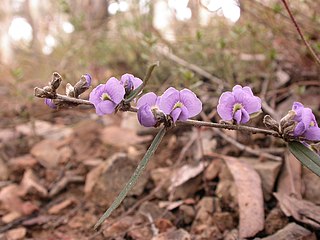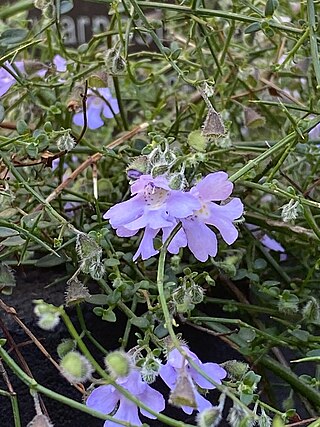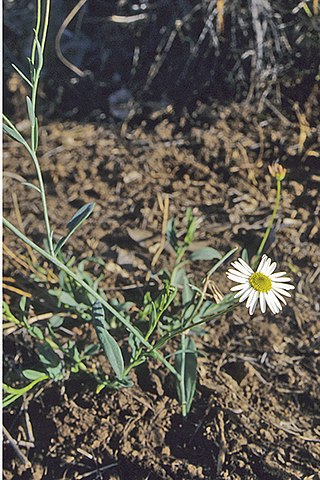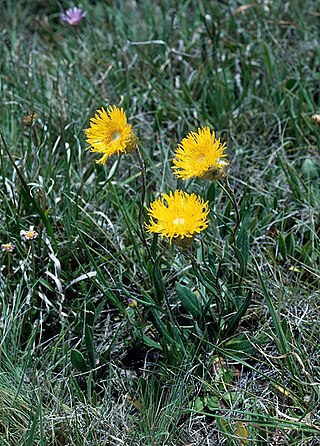
Hovea heterophylla, commonly known as creeping hovea, is a small shrub with linear leaves and purple-violet pea flowers. It is found in all states other than Western Australia.

Lobelia purpurascens, commonly known as white root or purplish pratia, is a flowering plant in the family Campanulaceae of eastern Australia. It is a small herbaceous, scrambling plant with white to pale pink flowers.

Velleia montana, commonly known as mountain velleia, is a flowering plant in the family Goodeniaceae. It is a small, perennial herb with tubular yellow flowers, mainly growing in woodland and sub-alpine grasslands in New South Wales, Victoria and Tasmania.

Scaevola hookeri, commonly known as the creeping fan-flower or alpine fan-flower, is a species of flowering plant in the family Goodeniaceae. It has white or blue flowers with a yellow throat and grows in eastern Australia.

Scaevola albida, commonly known as pale fan-flower or small-fruit fan-flower, is a flowering plant in the family Goodeniaceae. It is a spreading perennial herb with pale blue or white fan-shaped flowers and obovate leaves. It grows in Queensland through eastern New South Wales and coastal areas of Victoria and Tasmania.

Olearia floribunda, commonly known as heath daisy-bush, is a species of flowering plant in the family Asteraceae and is endemic to south-eastern Australia. It is an upright, spreading shrub with egg-shaped leaves and white and yellow or mauve, daisy-like inflorescences.

Olearia asterotricha, commonly known as rough daisy-bush, is a species of flowering plant in the family Asteraceae. A tall shrub with white, mauve or blue daisy like flowers growing from the Blue Mountains in New South Wales to western Victoria, Australia.

Prostanthera spinosa, commonly known as spiny mintbush, is a shrub that is endemic to south-eastern Australia. It has mauve to white flowers, spiny stems and aromatic foliage.

Brachyscome aculeata, commonly known as hill daisy, is a tufted perennial herb in the family Asteraceae and is endemic to Australia. It has mostly white daisy-like flowers, a yellow centre, variable shaped leaves and flowers in spring to autumn.

Brachyscome ascendens, the border ranges daisy, is a species of flowering plant in the family Asteraceae and is endemic to Australia. It has mostly mauve daisy-like flowers and a yellow centre.

Brachyscome graminea, commonly known as grass daisy, is a perennial herb in the family Asteraceae and is endemic to Australia. It has mostly mauve-pink or purple daisy-like flowers and a yellow centre.

Brachyscome basaltica, commonly known as swamp daisy, is a perennial herb in the family Asteraceae and is endemic to Australia. It has mostly white daisy-like flowers and a yellow centre.

Brachyscome dentata, commonly known as lobe-seed daisy, is a tufted perennial herb in the family Asteraceae and is endemic to Australia. It has mostly white or mauve daisy-like flowers, a yellow centre and pale green leaves. It is endemic to Australia.

Brachyscome nivalis, commonly known as snow daisy, is a perennial herb in the family Asteraceae and is endemic to Australia. It has mostly white daisy-like flowers, yellow centres and deeply lobed leaves.

Pultenaea humilis, commonly known as dwarf bush-pea, is a species of flowering plant in the family Fabaceae and is endemic to south-eastern Australia. It is a spreading, often low-lying shrub with branches that are hairy when young, elliptic to lance-shaped leaves with the narrower end towards the base, and yellow to orange and red flowers.

Olearia rugosa, commonly known as wrinkled daisy-bush, is a species of flowering plant in the family Asteraceae. It has alternate, wrinkled leaves and white daisy-like flowers and is endemic to south-eastern Australia.

Brachyscome bellidioides is a species of flowering plant in the family Asteraceae and is endemic to the southwest of Western Australia. It is an annual herb with linear leaves and yellow and white daisy-like flowers.

Podolepis decipiens, commonly known as deceiving copperwire-daisy, is a flowering plant in the family Asteraceae and grows in Victoria, Tasmania and New South Wales. It is an upright, perennial herb with yellow daisy-like flowers on a single stem rising from a sparse rosette.

Brachyscome spathulata, commonly known as spoon-leaved daisy, is a flowering plant in the family Asteraceae. It has dark green leaves, mauve daisy-like flowers and grows in New South Wales, Tasmania, Victoria and the Australian Capital Territory.

Brachyscome mittagongensis, is a flowering plant in the family Asteraceae and is endemic to New South Wales. It has white daisy-like flowers and a yellow centre.




















